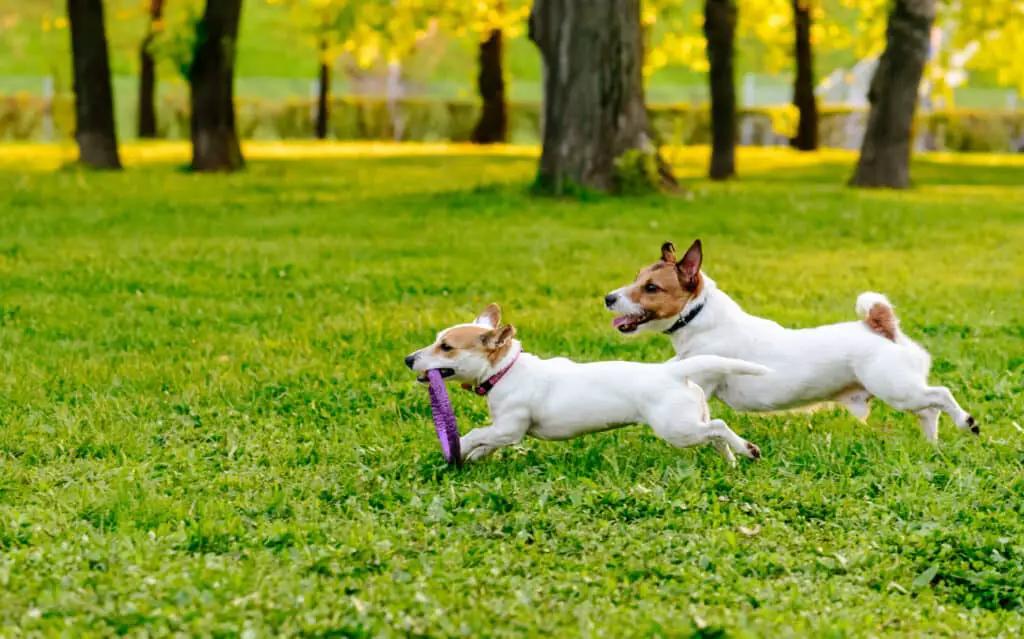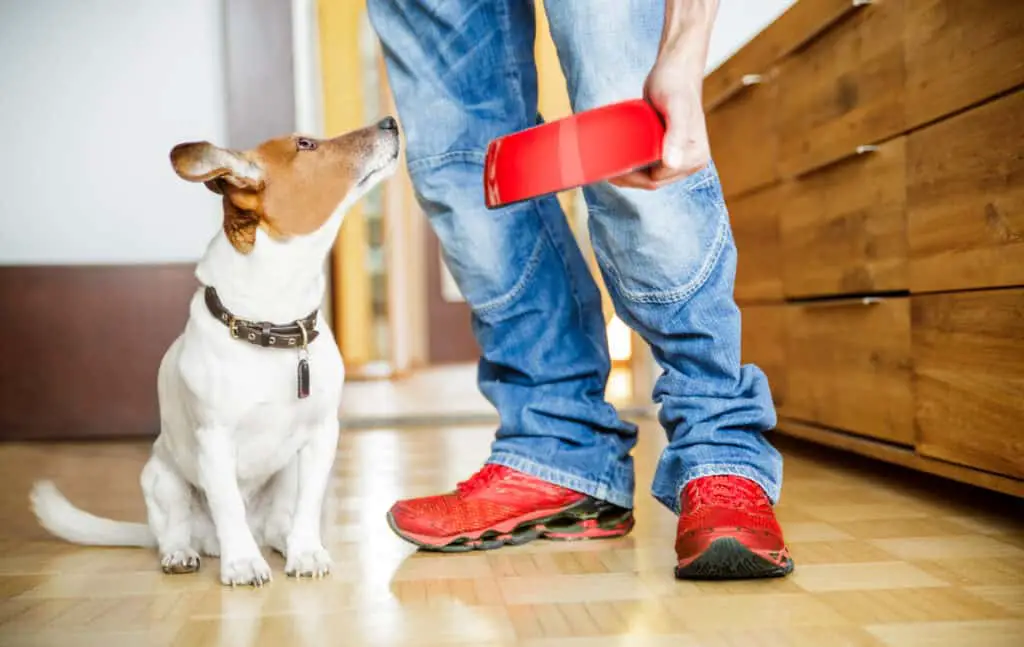Crates are an essential for any Jack Russell Terrier owner. They are useful for training puppies, or creating safe havens for older terriers, and are lifesavers during emergencies.
Crate training is a great way to create a safe, personal space in your home for your Jack Russell Terrier. Many terrier owners feel guilty at the thought of “locking up” their beloved pooch, but once trained, the enclosed space of a crate actually allows a Jack Russel Terrier to feel safe, rest and relax.
What are the benefits of crate training your Jack Russell Terrier?
Crate training your Jack Russell Terrier offers many practical benefits. Some of these include:
Toilet training
Once trained, Jack Russell Terriers consider their crate their ‘den’ and will generally not to urinate or defecate in their crate. This is especially handy if your terrier sleeps inside or spends time inside while you are not home.
Ensure your terrier goes to the toilet before going in the crate and ensure they have multiple opportunities to go to the toilet like after waking up or spending a long time in the crate. This is especially important if they are a puppy as they are still learning to control their bladder for long periods of time.
Providing a safe space for your dog
Sometimes when life becomes too chaotic or scary for your Jack Russell Terrier, a crate can become their safe haven they retreat to. In situations where there is lots of noise or people, your terrier can become overwhelmed, tired, stressed, or fearful. The safe space of a crate can help your terrier learn how to self soothe, or deal with their anxiety. A crate also helps your terrier manage new situations successfully, like the addition of a new baby.
A safe way to transport your Jack Russell Terrier
A crate is a safe way to transport your Jack Russell Terrier in the car, especially during long car trips. A crate allows your terrier to lay down and sleep without being able to move freely around the vehicle and distract the driver.
To safely travel with your Jack Russell Terrier by air, they must be transported in a crate. According to the American Veterinary Medical Association it is best to avoid sedatives during flights because sedation increases the risk of heart or respiratory problems. With these serious potential problems, it is especially important your terrier knows how to behave in a crate.
Easily confine your Jack Russell Terrier when needed
Sometimes when you are absent for short periods of time, a crate keeps your Jack Russell Terrier safe and away from potentially dangerous items around the house like electrical cables, which they may chew. It is also a great place to limit your terrier’s mobility while they recover from surgery or an injury.
When should I start crate training my Jack Russell Terrier?
Although Jack Russell Terriers can be crate trained at any age, the ideal time to start is when your terrier is a puppy. Ideally around the 8-week-old mark is the best time for most puppies and their owners. Older terrier may take more time to be crate trained.
How do I crate train my Jack Russell Terrier?
When crate training, it is important to be aware that the crate should always be associated with something positive, and training should take place in a series of small steps. Avoid trying to rush the training process, as each terrier adapts to the crate in their own time.
Step 1: Choose the right crate for Your Jack Russell Terrier
Finding the most suitable crate for your Jack Russell Terrier is key. Crates are available from most pet stores, and should be good quality, durable and comfortable.
It’s important that the crate you choose is the right size and isn’t too big or too small for your terrier. The crate should have enough room for your terrier to stand up, lie down, stretch, and turn around. If you are crate training a puppy, ensure the crate is large enough to suit them once fully grown or be prepared to upgrade to a larger crate when needed.
Step 2: Introduce your Jack Russell Terrier to the crate
Jack Russell Terriers are very social and love to be around us, so to begin with, place the crate in an area of your home where the family spends a lot of time, such as the living room. Create a comfy environment for your Jack Russell Terrier by putting a soft bed and one of their favourite toys in the crate.
It is best to remove the door at this stage of the training process rather than just prop it open – your terrier could develop negative associations with the crate if the door accidently frightens them or shuts, trapping them inside.
Some terriers are naturally curious and will explore the crate and perhaps start sleeping in the crate right away. If yours isn’t one of them:
- Encourage your terrier to enter the crate by placing some treats around the door as well as just inside. Remember don’t force them to go in and if they refuse to go all the way, that’s ok, allow them to enter the crate in their own time.
- Continue the process of placing treats in the crate until your terrier calmly walks all the way in to get the food.
- Once your terrier is happily entering the crate for treats or toys, another way to develop a positive association with the crate is to give them a KONG toy filled with peanut butter. This will get them used to being in the crate for a longer period, while also associating it with an enjoyable activity.
Be patient, this step may take a few minutes or as long as several days.
Step 3: Feed your Jack Russell Terrier full meals in the crate
Once you have introduced your Jack Russell Terrier to the crate, try feeding them their regular meals in the crate. Start gradually by placing the food bowl near, but outside the crate. Once your terrier is comfortable with this try moving their bowl just inside the door of the crate. Then slowly move their bowl further back into the crate with subsequent meals as they become more comfortable.
When your terrier is happy to eat in the crate, place their food in the crate and close the crate door once they are inside. Keep the door closed while they eat and open it just before they finish their meal. Increase the duration of time they are in the crate by a few minutes each time once they finish their meal.
At this stage you want to aim for them to stay in the crate for 10 minutes or so after eating. If they start to whine while locked in the crate, you may have increased the length of time too quickly and may need to reduce the duration next time they are in the crate.
Step 4: Practice longer periods of time in the crate
The next step, once your Jack Russell Terrier is happily entering and eating in the crate, is to confine your terrier in the crate for short periods of time. This needs to be done while you are home, so you can monitor their fear and anxiety levels.
Begin by calling your terrier over to the crate and offering them a treat. Use a cue word like “crate” or “bed” and have another treat in your hand as you point inside the crate to encourage them to enter.
Once your terrier is inside the crate, praise them, give them the treat, and close the door. It’s a good idea to sit quietly near the crate for about five minutes before leaving for a short period of time. Not leaving straight away helps to reduce negative association between being locked in the crate and you leaving. When your return, sit quietly next to the crate again for another five minutes before letting your terrier out.
Practice is key here, so continue to repeat this process several times a day. Each time try increasing the length of time you leave your terrier in the crate and the length of time you are out of sight. Gradually increase the total time your terrier is in the crate calmly and quietly with you in and out of sight to 30 minutes.
Remember to keep an eye on the time and ensure your terrier has lots of breaks between crate training – time outside the crate to play, eat, and use the bathroom. Jack Russell Terriers don’t like to soil where they sleep, but if there’s too long of a stretch without a decent break, they might end up doing so.
Step 5: Crate your Jack Russell Terrier when you leave the house
You can begin leaving your Jack Russell Terrier crated when you leave the house for short periods once they are happily spending about 30 minutes in the crate at a time.
Once you crate your terrier like you normally would with a command and a treat, it’s a good idea to leave them with a few safe toys or perhaps a KONG toy filled with peanut butter in the crate. This will give them something else to focus on rather than you leaving them.
Try to make your departures matter of fact and avoid any emotional and prolonged goodbyes; briefly praise your terrier and leave. Although your terrier shouldn’t be crated for long periods of time, try to vary the moment you crate them (anywhere from 5 to 20 minutes) as you are preparing to leave the house. They are very receptive to repetitive patterns and by varying certain routines, will avoid negative associations of being left alone.
Upon your return keep your arrival low-key and avoid rewarding your terrier for excited behavior. Responding to your terrier in an enthusiastic way can increase their anxiety over when you will return. Regularly crate your for terrier for short periods of time when you are home so they don’t associate crating with being left alone.
Step 6: Crate your Jack Russell Terrier at night
When beginning crate training at night it’s a good idea to put the crate in your bedroom or nearby in a hallway, especially if you have a puppy. A puppy can only control their bladder one hour for every month of age so they will need to go outside to eliminate during the night and you will be able to hear your puppy whine to be let outside when they are close by. It’s also a good idea to keep older dogs nearby so they don’t associate the crate with social isolation.
Once your terrier is sleeping comfortably through the night in the crate nearby, you can begin to gradually move it to the location you prefer, like the laundry.
Step 7: Be Patient
Most Jack Russell Terriers will adjust to their crates rather quickly, but you should start crate training with the mindset that it will take some time and work on your behalf. And while there is no set time frame for crate training, expect it to take two months or more.
It is important to stay calm and consistent in your methodology and remember crate training is a training process, and every terrier learns at their own pace but eventually they realize their crate is their safe space and will happily go there.
Important things to be aware of when crate training your Jack Russell Terrier
Jack Russell Terriers should never be left locked in their crate for excessive periods of time, such as during the day while you are at work. When their physical and psychological needs are reduced, they feel stressed and trapped, which can lead to behavioural problems and reluctance to be crated. Adult terriers should not be left for more than 3-4 hours in a crate, and puppies not more than 1-2 hours.
The primary purpose of a crate is to provide a safe space for your terrier. A crate should never be used as a form of punishment. If your terrier is barking or whining while in the crate never yell at them or bang on the crate to stop the behaviour as it may cause fear. These behaviours may mean they need to go to the toilet or they may just want to be let out.
It is important to remove collars with tags before crating your terrier. Tags can become caught in the crate and your terrier can be injured or strangled.
Sources:
How to Crate Train Your Dog in Nine Easy Steps – American Kennel Club (akc.org)
Traveling with your pet FAQ | American Veterinary Medical Association (avma.org)





![How Much Exercise Does A Jack Russell Terrier Need? [Complete guide for all life stages]](https://jackrussellsunleashed.com/wp-content/uploads/2022/03/iStock-1143749718-1024x683.jpg)
